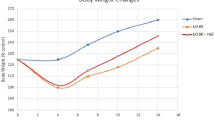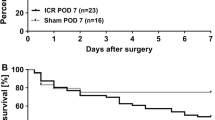Abstract
Purpose
It has been reported that oral insulin (OI) has a trophic effect on intestinal mucosa. In the present study, we evaluated the effect of OI on enterocyte turnover and correlated it with insulin-receptor expression along the villus–crypt axis in a rat model of short bowel syndrome (SBS).
Methods
Male rats were divided into three groups: Sham rats underwent bowel transection, SBS rats underwent a 75% bowel resection, and SBS–OI rats underwent bowel resection and were treated with OI given in drinking water (1 U/ml) from the fourth postoperative day. Parameters of intestinal adaptation, enterocyte proliferation and apoptosis were determined on day 15. Real-time PCR was used to determine the level of insulin receptor-beta (IRB) mRNA. Insulin-receptor expression along the villus–crypt axis (villus tips, lateral villi and crypts) was assessed by immunohistochemistry. The effect of OI on cell turnover for each compartment was evaluated in correlation with the receptor expression. Statistical analysis was performed using the one-way ANOVA test, with P < 0.05 considered statistically significant.
Results
Treatment with OI resulted in a significant increase in all parameters of intestinal adaptation. Insulin-receptor expression in crypts significantly increased in SBS rats (vs. Sham rats) and was accompanied by a significant increase in enterocyte proliferation following OI administration. A significant increase in insulin-receptor expression at the tip of the villous and in the lateral villous in SBS rats (vs. Sham) was accompanied by decreased cell apoptosis in these compartments following treatment with OI.
Conclusions
In a rat model of SBS, OI enhances enterocyte turnover and stimulates intestinal adaptation. The stimulating effect of insulin on enterocyte turnover correlates with insulin-receptor expression along the villus–crypt axis.






Similar content being viewed by others
References
Coran AG, Spivak D, Teitelbaum DH (1999) An analysis of the morbidity and mortality of short bowel syndrome in the pediatric age group. Eur J Pediatr Surg 9:228–230
Robinson MK, Ziegler TR, Wilmore DW (1999) Overview of intestinal adaptation and its stimulation. Eur J Pediatr Surg 9:200–206
Sigalet DL, Martin GR (1998) Mechanisms underlying intestinal adaptation after massive intestinal resection in the rats. J Pediatr Surg 33:889–892
Podolsky DK (1994) Peptide growth factors in the gastrointestinal tract. In: Johnson LR (ed) Physiology of the gastrointestinal tract, 3rd edn. Raven Press, New York, pp 129–167
Yang H, Antony PA, Wildhaber BE, Teitelbaym DH (2004) Intestinal intraepithelial lymphocyte gamma delta-T cell-derived keratinocyte growth factor modulates epithelial growth in the mouse. J Immunol 172:4151–4158
Warner BW, VanderKolk WE, Can G, Shin CF, Erwin CR (1997) Epidermal growth factor receptor expression following small bowel resection. J Surg Res 70:171–177
Sukhotnik I, Mogilner JG, Shaoul R, Karry R, Lieber M, Suss-Toby E, Ure BN, Coran AG (2008) Responsiveness of intestinal epithelial cell turnover to TGF-α after bowel resection in a rat is correlated with EGF receptor expression along the villus–crypt axis. Pediatr Surg Int 24:21–28
Lund PK (1998) Molecular basis of intestinal adaptation: the role of the insulin-like growth factor system. Ann N Y Acad Sci 859:18–36
Lemmey AB, Martin AA, Read LC, Tomas FM, Owens PC, Ballard FJ (1991) IGF-I and the truncated analogue des-(1–3)IGF-I enhance growth in rats after gut resection. Am J Physiol 260:E213–E219
Buts JP, de Kayser N, Dive C (1988) Intestinal development in the suckling rat: effect of insulin on the maturation of villous and crypt functions. Eur J Clin Invest 18:391–398
Georgiev IP, Georgieva TM, Pfaffl M, Hammon HM, Blum JW (2003) Insulin-like growth factor and insulin receptors in intestinal mucosa of neonatal calves. J Endocrinol 176:121–132
Sukhotnik I, Shehadeh N, Shamir R, Bejar J, Bernshteyn A, Mogilner JG (2005) Oral insulin enhances intestinal re-growth following massive small bowel resection in rat. Dig Dis Sci 50:2379–2385
Shamir R, Kolacek S, Koletzko S, Tavori I, Bader D, Litmanovitz I, Flidel-Rimon O, Marks KA, Sukhotnik I, Shehadeh N. Oral insulin supplementation in pediatric short bowel disease. A pilot observational study. J Pediatr Gastroenterol Nutr JPGN (in press)
Chromszynski P (1993) A reagent for the single-step simultaneous isolation of RNA, DNA and proteins from cell and tissue samples. Biotechniques 15:532–536
Weale AR, Edwards AG, Bailey M, Lear PA (2005) Intestinal adaptation after massive intestinal resection. Postgrad Med J 81:178–184
Donovan SM, Hintz RL, Rosenfeld RG (1991) Insulin-like growth factors I and II and their binding proteins in human milk: effect of heat treatment on IGF and IGF binding protein stability. J Pediatr Gastroenterol Nutr 13:242–253
Young GP, Taranto TM, Jonas HA, Cox AJ, Hogg A, Werther GA (1990) Insulin-like growth factors and the developing and mature rat small intestine: receptors and biological actions. Digestion 46(Suppl 2):240–252
Han VK, Lund PK, Lee DC, D’Ercole AJ (1988) Expression of somatomedin/insulin-like growth factor messenger ribonucleic acids in the human fetus: identification, characterization, and tissue distribution. J Clin Endocrinol Metab 66:422–429
Lund PK (1988) Molecular basis of intestinal adaptation: the role of the insulin-like growth factor system. Ann N Y Acad Sci 859:18–36
Shulman RJ (1990) Oral insulin increases small intestinal mass and disaccharidase activity in the newborn miniature pig. Pediatr Res 28:171–175
Shamir R, Muslach M, Sukhotnik I, Perlman R, Diamond E, Mogilner J, Shehadeh N (2005) Intestinal and systemic effects of oral insulin supplementation in rats after weaning. Dig Dis Sci 50:1239–1244
Acknowledgments
This work was supported by an Israel Science Foundation (ISF) research grant.
Author information
Authors and Affiliations
Corresponding author
Rights and permissions
About this article
Cite this article
Ben Lulu, S., Coran, A.G., Mogilner, J.G. et al. Oral insulin stimulates intestinal epithelial cell turnover in correlation with insulin-receptor expression along the villus–crypt axis in a rat model of short bowel syndrome. Pediatr Surg Int 26, 37–44 (2010). https://doi.org/10.1007/s00383-009-2520-x
Published:
Issue Date:
DOI: https://doi.org/10.1007/s00383-009-2520-x




